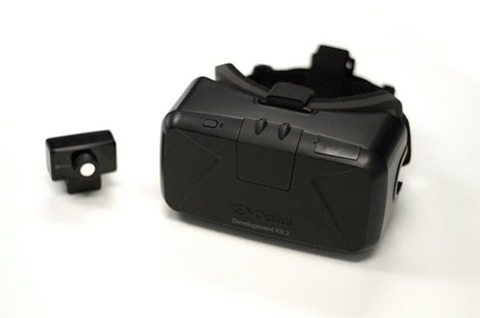Overview
Oculus Rift is a virtual reality headset developed by Oculus VR, headed by Palmer Luckey. The headset's primary features are low-latency head-tracking and a wide field of view.
The Rift is being built with out-of-the-box engine integration with Unreal Engine and Unity.
The consumer version of the Rift was released in March 2016 and pre-orders began on 6th January. A wireless Xbox One controller will come packed in with every consumer version of the device along with EVE: Valkyrie, and Lucky's Tale.
Kickstarter
In August 2012, Oculus VR launched a Kickstarter campaign in order to fund the production of developer prototypes of the Rift, with a goal of $250,000. Rewards included t-shirts, posters and, for those pledging $300 or more, the development prototype and access to the SDK after the first production run.
The kickstarter goal was met, with the total amount pledged almost reaching $2,5 million by roughly 9,500 backers. After the Kickstarter, Oculus VR opened up pre-orders for the same prototype at the same price on their website. Production of the Rift prototype began, with shipping initially estimated to begin in December 2012.
Facebook Acquisition
On March 25th 2014, Facebook announced that they would be acquiring Oculus VR for $2 billion in cash and shares of Facebook stock.
“Mobile is the platform of today, and now we’re also getting ready for the platforms of tomorrow. Oculus has the chance to create the most social platform ever, and change the way we work, play and communicate.”
Facebook founder and CEO, Mark Zuckerberg.
After the announcement, Minecraft creator Notch announced on his personal blog that he would be cancelling talks with Oculus VR regarding working with them in order to bring Minecraft to the rift.
We were in talks about maybe bringing a version of Minecraft to Oculus. I just cancelled that deal. Facebook creeps me out.
— Markus Persson (@notch) March 25, 2014
Prototype
The initial features of the Rift protoype, as detailed on the Kickstarter page, were:
- 6 degrees of freedom motion sensors
- 1280x800 resolution
- Fish-eye optics
- A high field of view(90 degrees horizontal, 110 degrees diagonal)
- Packed in of Doom 3 BFG Edition, the first game to support the Rift
Notable differences between the Rift and other head-mounted displays were the low latency motion sensors and the fish-eye optics.
A 6DOF motion sensor includes two 3-axis sensors, an accelerometer for tracking orientation and a magnetometer for reducing error in pitch and roll. The fish-eye lenses were meant to focus the user’s vision on the display in order to minimize the effect of looking at a screen at a distance, which other HMD’s suffer from.
Prototype revision
A Kickstarter update sent out in late 2012 revealed that, because of the unexpectedly high amount of prototypes needing production, the production pipeline had to be changed. This resulted in a delay, with shipping estimated to occur in March 2013, as well as some improvements to the hardware of the prototype. The screen used, while the same resolution, would be larger(7” instead of the original 5.6”), with faster pixel switching as well as having a higher contrast and pixel fill factor. Having a higher fill factor means having the pixels take up a larger portion of the panel, reducing the visible black grid seen between pixels(the “screen door effect”). A large addition was the change from 6DOF sensors to 9DOF sensors, meaning the Rift would additionally incorporate a 3-axis magnetometer.
Development Kit 2
The second version of developer hardware began shipping out to those who pre-ordered them for $350 starting early July 2014.

While not identical to the planned consumer Rift, key additions are present which include a higher resolution screen with a low-persistence screen and a sensor that allows low-latency positional head tracking.
- 960 x 1080 resolution per eye (1920 x 1080 screen)
- 75 Hz, 72 Hz, 60 Hz Refresh Rate
- Positional Tracking using Near Infrared CMOS Sensor at 60 Hz
- 100 degree Field of View
- Gyroscope, Accelerometer, Magnetometer sensors updating at 1000 Hz
- 0.97 lbs (without cables)
Supported games
The Oculus Rift currently supports the following game releases:
Trivia
- In 1991, Sega introduced a similar head-tracking, VR headset called the Sega VR. After various demonstrations at shows and arcades in the 90's (such as the Sega VR-1 attraction), the device was not heard from again. Oculus VR mentioned the Sega headset as one of the influences that they wanted to improve on.
Log in to comment